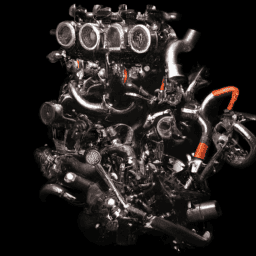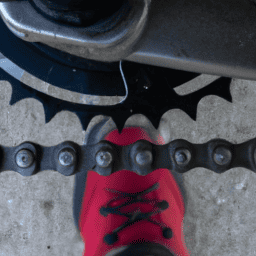Have you ever come across the adage, “a chain is no stronger than its weakest link?” This saying, while it might have roots in the industrial realm, is undeniably relevant to cycling too. Being a cyclist myself, I understand that the chain plays a crucial role in my bike. It is the device that converts the strength of my pedaling into motion, driving me onwards.
But have you ever wondered what bicycle chains are made of and why it matters? In this article, I’ll explore the common materials used in bicycle chains, the pros and cons of each material, and the factors you should consider when choosing a chain for your bike.
Bicycle chains may seem like a simple component, but they are actually quite complex. The chain has to be strong enough to withstand the force generated by the rider, but also lightweight and flexible enough to move smoothly through the gears. In other words, it’s a delicate balance between strength and agility. And the material the chain is made of plays a critical role in achieving that balance.
So, let’s dive into the world of bicycle chains and explore what they’re made of.
Key Takeaways
- Bicycle chains are essential components that transfer power from legs to wheels and need to be strong, lightweight, and flexible.
- Steel is the most common material used for bicycle chains due to its strength, rigidity, and affordability. It is often heat treated and treated with corrosion-resistant coatings.
- Other materials used for bicycle chains include titanium (known for durability, weight reduction, and smooth riding), nickel-plated (a cost-effective alternative to steel with improved wear resistance and low maintenance), and ceramic (extremely durable and resistant to wear, but more expensive and less widely available than steel).
- When choosing a bicycle chain, factors such as durability, weight, compatibility with drivetrain, and type of riding should be considered. Lubrication and cleaning are also essential for optimal performance, and the impact on the environment should be taken into account by choosing recycled or bio-based materials.
The Importance of Bicycle Chains
You can’t underestimate the significance of your bike chain – it’s what connects your pedaling power to the wheels, making it an essential component for a smooth and efficient ride.
However, like any mechanical part, it can wear out over time. Chain wear is a common issue that can lead to poor shifting, chain skipping, and even chain failure.
To prevent this, it’s essential to keep your chain lubricated and clean. Lubrication techniques can vary, but generally, it’s best to use a lubricant designed specifically for bicycle chains. This will help reduce friction and wear, preventing premature failure.
It’s also important to keep your chain clean, as dirt and debris can accelerate wear. By regularly inspecting and maintaining your chain, you can ensure that it performs at its best for many miles to come.
With that being said, let’s dive into the common materials used in bicycle chains.
Common Materials Used in Bicycle Chains
I’ll be discussing the common materials used in bicycle chains.
As a cyclist, I’m well aware of the importance of a durable and reliable chain. Steel is the most commonly used material due to its strength and affordability. However, other options such as titanium, nickel-plated, and ceramic are also available for those looking for specific properties in their chain.
Steel
Steel is a durable material that is commonly used to make bicycle chains. It is an alloy composed of iron, carbon, and other trace elements. Steel is an ideal material for bicycle chains because of its strength, rigidity, and resistance to wear and tear. It’s also relatively inexpensive compared to other materials used in bicycle chains.
In order to improve the strength and durability of steel, it undergoes a process called heat treatment. This process involves heating the steel to a specific temperature and then cooling it rapidly. This process alters the properties of the steel, making it harder and more resistant to wear and tear.
Additionally, steel is also treated with corrosion-resistant coatings to protect it from rust and other environmental factors that can damage it.
Now, moving on to the next subtopic, titanium is another material that is gaining popularity in the production of bicycle chains.
Titanium
Titanium is becoming increasingly popular in the production of bike chains due to its strength and light weight, making it a great option for those looking to upgrade their ride. Here are some advantages and disadvantages of using titanium chains:
Advantages:
- Durability: Titanium is highly resistant to corrosion and can withstand harsh weather conditions, making it a great choice for outdoor cycling.
- Weight: Titanium is one of the lightest metals available, making it a popular choice among competitive cyclists who’re looking to reduce weight on their bikes.
- Smooth riding: Titanium chains are known for their smooth and quiet operation, providing a comfortable ride for the cyclist.
Disadvantages:
- Cost: Titanium is an expensive material, making titanium chains more expensive than their steel counterparts.
- Compatibility: Titanium chains may not be compatible with all bike components, so it’s important to check compatibility before purchasing.
- Wear and tear: While titanium is durable, it may not be as wear-resistant as other materials, so regular maintenance is important to ensure longevity.
Moving on to the next subtopic, nickel-plated chains offer a different set of advantages and disadvantages compared to titanium chains.
Nickel-plated
Nickel-plated chains provide a cost-effective alternative for those who want a durable and rust-resistant bicycle chain. The nickel plating on the chain reduces the risk of corrosion and rust, which helps maintain the chain’s longevity. Additionally, nickel-plated chains have improved wear resistance, making them a great choice for those who ride frequently or in harsh weather conditions.
One of the advantages of nickel-plated chains is that they’re relatively low maintenance. They require less frequent lubrication and cleaning than non-plated chains, which can save time and money in the long run. With their durability and resistance to rust, nickel-plated chains are a great choice for both casual riders and serious cyclists who need a reliable and long-lasting chain.
Moving on to the next section about ceramic, it’s important to note that while nickel-plated chains offer many benefits, ceramic chains take durability and wear resistance to the next level.
Ceramic
If you’re looking for the ultimate in durability and wear resistance, ceramic chains may be the right choice for you. For example, imagine you’re a competitive mountain biker and you need a chain that can withstand the toughest terrain and conditions.
Here are some advantages and disadvantages of ceramic chains:
-
Advantages:
-
Ceramic chains are extremely durable and resistant to wear.
-
They’re also lightweight, which can improve your bike’s performance.
-
Ceramic chains are also less likely to rust, which can be a major advantage in wet conditions.
-
They require less maintenance than steel chains, which can save you time and money.
-
Disadvantages:
-
Ceramic chains are more expensive than steel chains, which may be a drawback for some riders.
-
They’re also more brittle than steel chains, which means they may be more prone to breaking.
-
Ceramic chains are not as widely available as steel chains, which can make it more difficult to find replacement parts.
-
They may not be suitable for all types of riding, as they may not be able to withstand extreme loads or impacts.
Overall, ceramic chains offer some significant advantages over steel chains in terms of durability and performance. However, they also come with some drawbacks that should be considered before making a purchase. In the next section, we’ll explore the pros and cons of different chain materials in more detail.
Pros and Cons of Different Chain Materials
You’ll notice that steel chains, while heavy, are durable and affordable options for most cyclists. They are made of high-strength steel alloys which are able to withstand the stresses of regular use. However, their weight may be a drawback for some riders who prioritize speed and efficiency.
To compare the tradeoffs between different chain materials, it’s important to consider their strength versus weight ratios. The heavier the chain, the more durable it tends to be, but also the more sluggish it can make the bike. On the other hand, lighter chains offer better performance but may not be as durable. Additionally, the choice of chain material can have an impact on the environment, as some materials are more sustainable than others. For example, chains made of recycled metals or bio-based materials have a lower environmental impact than those made from virgin metals.
When choosing a bicycle chain, there are several factors to consider beyond just the material. These include chain width, compatibility with the bike’s drivetrain, and the type of riding the chain will be used for.
Factors to Consider When Choosing a Bicycle Chain
Now that we’ve discussed the pros and cons of different chain materials, let’s talk about the factors to consider when choosing a bicycle chain.
One major factor is chain durability. A stronger and more durable chain material, such as stainless steel, will last longer and require less frequent replacements. However, these chains tend to be heavier and may not be ideal for weight optimization.
Another important consideration is the weight of the chain. A lighter chain material, such as titanium, can help reduce the overall weight of the bike and increase its speed. However, lighter chains may not be as durable and may need to be replaced more frequently.
Ultimately, the choice of chain material will depend on the rider’s specific needs and preferences.
As we move on to the next section, it’s important to note that proper maintenance and timely replacement of your bicycle chain is essential to ensure optimal performance and safety.
Maintaining and Replacing Your Bicycle Chain
Proper maintenance and timely replacement are crucial for ensuring optimal performance and safety of your bike’s chain. Chain wear is a common issue that can lead to poor shifting, chain slipping, and even chain breakage. To avoid these problems, you need to regularly inspect your chain and replace it when it shows signs of wear.
One way to check for chain wear is to use a chain wear indicator tool. This tool measures the distance between the chain’s links and can indicate whether the chain is stretched beyond its recommended length. Another way to check for wear is to look for signs of rust, kinks, or discoloration on the chain. If you notice any of these issues, it’s time to replace your chain. Additionally, regular chain lubrication can help prolong the life of your chain and improve its performance. When lubricating your chain, be sure to use a lubricant specifically designed for bicycle chains and follow the manufacturer’s instructions for application.
Frequently Asked Questions
How do I know when my bike chain needs to be replaced?
I can tell my bike chain needs replacement by checking for elongation, rust, or stiff links. Regular bike chain maintenance is key to avoiding wear and tear, which can cause skipping gears and reduce efficiency.
Can I use any type of lubricant on my bike chain?
Before lubricating your bike chain, ensure it’s clean and dry. Chain maintenance tips include wiping the chain down after every ride. The best lubricants for bike chains are dry, wet, and wax-based.
What is the difference between a single-speed and a multi-speed bike chain?
Single-speed and multi-speed chains differ in width and durability. Multi-speed chains are narrower and require more maintenance, but offer faster and smoother shifting. Proper lubrication and chain cleaning techniques are crucial for both types of chains.
Can a worn-out bike chain damage other parts of my bike?
Chain wear can lead to damage of other bike parts. Regular chain maintenance is important to prevent this. Measuring chain wear can be done with a simple tool called a chain checker.
Can I repair a broken bike chain, or do I need to replace it entirely?
If a bike chain breaks, repairing it is possible with chain repair methods such as using a chain tool or replacing the damaged link. However, cost effective replacements are also available and may be a better option.
Conclusion
Well folks, that concludes our discussion on what bicycle chains are made of. As a cycling enthusiast myself, I can’t stress enough the importance of having a reliable and sturdy chain on your bike.
From the materials used to the factors to consider, we’ve covered it all. When it comes to choosing the right chain for your ride, it’s important to consider your riding style, terrain, and budget.
And don’t forget to maintain and replace your chain regularly to ensure optimal performance and prevent any mishaps while on the road or trail.
In conclusion, whether you’re a casual cruiser or a hardcore mountain biker, understanding the composition and function of your bicycle chain is key to a successful ride. So, get out there, hit the road, and enjoy the ride – but don’t forget to keep that chain greased and in top shape!
As we say in the cycling world, "keep the rubber side down and the pedals turning."Happy cycling!









